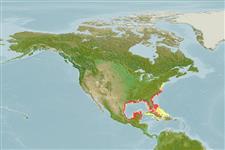>
Siluriformes (Catfishes) >
Ariidae (Sea catfishes) > Ariinae
Etymology: Ariopsis: Greek, ari = very, strength, superiority + Greek, opsis = appearance (Ref. 45335).
More on author: Linnaeus.
Environment: milieu / climate zone / depth range / distribution range
Ecologia
marinhas; estuarina associadas(os) a recifes. Subtropical; 43°N - 18°N, 98°W - 68°W
Western Atlantic: Massachusetts and northern Gulf of Mexico to southern Florida in USA and Mexico.
Comprimento de primeira maturação / Tamanho / Peso / Idade
Maturity: Lm ?, range 13 - ? cm
Max length : 70.0 cm TL macho/indeterminado; (Ref. 40637); common length : 25.0 cm TL macho/indeterminado; (Ref. 3265); peso máx. publicado: 5.5 kg (Ref. 7251)
This species is distinguished from its congeners by the following characters: gill rakers on the first and second gill arches 29-32; osseous medial groove present; fleshy medial groove of neurocranium conspicuous and long, always surpassing the posterior margin of eyes; lateral margin of sphenotic notched, narrower medially than anteriorly; pterotic lateral margin smoothly convex; lateral margin of sphenotic notched, narrower medially than anteriorly; mouth 9.1-11.5% SL; close anterior nostrils 4.6-6.4% SL, close posterior nostrils 4.2-7.1% SL; mesethmoid median portion narrow, mesethmoid medial notch narrow and deep; gill rakers on the first gill arch 13–15, rarely 16; external posterior branch of lateral ethmoid columnar and thin; fenestra delimited by mesethmoid and lateral ethmoid conspicuous (Ref. 116660).
Adults inhabit continental waters and enter estuaries. Found in turbid waters over muddy bottoms. Males incubate eggs in the mouth (Ref. 205). Commonly captured from catwalks, bridges and piers, particularly in passes and inland waterways. Edible, but generally not consumed (Ref. 7251).
Males carry the eggs in the mouth (Ref. 205).
Marceniuk, A.P., A.P. Acero, R. Cooke and R. Betancur-R, 2017. Taxonomic revision of the new world genus Ariopsis Gill (Siluriformes: Ariidae), with description of two new species. Zootaxa 4290(1):1-42. (Ref. 116660)
Status na Lista Vermelha da UICN (Ref. 130435: Version 2024-2)
Ameaça para os humanos
Traumatogenic (Ref. 58010)
Uso pelos humanos
Pescarias: pouco comercial; peixe esportivo: sim
Ferramentas
Relatórios especiais
Baixar XML
Fontes da internet
Estimates based on models
Preferred temperature (Ref.
123201): 23.3 - 27.8, mean 26.4 °C (based on 368 cells).
Índice de diversidade filogenética (Ref.
82804): PD
50 = 0.5625 [Uniqueness, from 0.5 = low to 2.0 = high].
Bayesian length-weight: a=0.00631 (0.00513 - 0.00775), b=3.16 (3.10 - 3.22), in cm total length, based on LWR estimates for this species (Ref.
93245).
Nível Trófico (Ref.
69278): 3.2 ±0.0 se; based on diet studies.
Resiliência (Ref.
120179): Baixo, tempo mínimo de duplicação da população 4,5 - 14 anos (Fec=55).
Fishing Vulnerability (Ref.
59153): Moderate to high vulnerability (48 of 100).
Nutrients (Ref.
124155): Calcium = 23.7 [8.3, 68.5] mg/100g; Iron = 0.501 [0.257, 0.899] mg/100g; Protein = 18.3 [16.5, 20.3] %; Omega3 = 0.13 [0.06, 0.26] g/100g; Selenium = 16.3 [7.1, 38.2] μg/100g; VitaminA = 37.1 [11.4, 129.3] μg/100g; Zinc = 0.927 [0.557, 1.534] mg/100g (wet weight);
